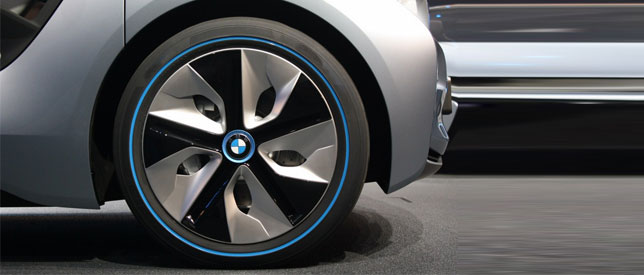Good Bye Alloys, Say Hello to Carbon Fibre
 21Feb14
21Feb14BMW is planning to launch carbon-fibre technologies across BMW new model line-up
• Alloys will be a thing from the past in just two years time
• BMW will roll out carbon fibre alloys and rims across its entire range
• Technology developed during the i3 and i8 project
BMW is planning to launch carbon-fibre technologies developed during the BMW i3 and i8 project and star of the show is a set of ultra-light, fully carbon fibre rims. The man behind this scheme is BMW’s lightweight construction manager, Franz Storkenmaier. Among other things BMW team has developed, is carbon fibre steering wheel, a new carbon-plastic compound that is light and strong and a one-piece carbon fibre propeller shaft for the BMW X5. All this has been made from i3 production waste. BMW hasn’t ended this new venture at new wheels, but it has also developed a carbon fibre/alloy hybrid wheel, with alloy spokes and a carbon fibre rim.
BMW now faces a tough task to convince European regulators that these are strong enough to be safe on the roads. Mr Storkenmaier said, “We save 25 percent in weight compared to a forged alloy wheel with the hybrid wheel and another 10 percent if it’s completely carbon.” BMW is also aware of the concerns that carbon fibre is not good at bending, “It’s the most important kind of weight because it’s unsprung mass and there are also rotating mass advantages.,” said Mr Storkenmaier. “The carbon fibre wheels are very damage resistant. They’re actually more damage resistant to kerb hits than standard alloy wheels because the damage polishes out really easily. “You can scratch it when you park and it’s better to polish out than aluminium. You can have the metal finish to it with the alloy hybrid, but it’s technically a better solution to go all the way and have a full carbon fibre wheel.”
“The protection for the carbon steering wheel is the airbag. If you physically hit the steering wheel, it will not deform and you’ve already lost. That’s the same with metallic steering wheels.” “We are the very first car maker to use carbon fibre on an industrial scale. Now are we able to use the leftover from the mainstream production on an industrial scale, too.” “Carbon fibre is an expensive material to work with, but if you are using production waste then it’s a different cost structure from working up raw carbon fibre. It’s cheap, and that’s how we can position it as a competitor to magnesium.”